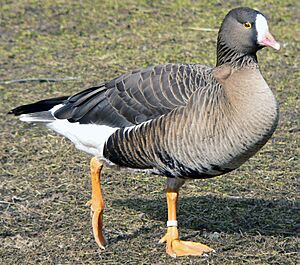Lesser white-fronted goose facts for kids
Quick facts for kids Lesser white-fronted goose |
|
|---|---|
 |
|
| Conservation status | |
| Scientific classification | |
| Genus: |
Anser
|
| Species: |
erythropus
|
 |
|
| Range of A. erythropus Breeding Non-breeding Passage Vagrant (seasonality uncertain) Possibly Extant (passage) | |
| Synonyms | |
|
Anas erythropus Linnaeus, 1758 |
|
The lesser white-fronted goose (Anser erythropus) is a type of goose. It is a bit smaller than its close relative, the greater white-fronted goose. These geese live and breed in the far northern parts of Europe and Asia. They are quite rare in Europe. Sometimes, people try to help them by releasing geese back into the wild in places like Fennoscandia (parts of northern Europe).
Contents
What's in a Name?
The lesser white-fronted goose got its official name in 1758. A Swedish scientist named Carl Linnaeus gave it the scientific name Anas erythropus. He wrote about it in his famous book, Systema Naturae.
Later, scientists decided this goose belonged to a different group, or genus, called Anser. The name Anser is Latin for "goose." The second part of its name, erythropus, means "red-footed" in old Greek. This is because of its bright red feet!
Where These Geese Live and Travel
These geese spend their summers breeding in the far north. When winter comes, they fly south to warmer places in Europe and Asia. They are not often seen in places like Great Britain or India.
Long ago, some of these geese regularly visited a special place in England called WWT Slimbridge. This inspired a man named Sir Peter Scott to start The Wildfowl and Wetlands Trust. This group works to protect wild birds and their homes. Today, fewer lesser white-fronted geese visit England because their numbers have gone down in Europe.
Sometimes, you might see a goose that looks like this one in summer. It might even be with other geese that are not wild. These could be geese that have escaped from bird collections.
How to Spot a Lesser White-Fronted Goose
It can be tricky to tell the lesser white-fronted goose apart from its larger cousin, the greater white-fronted goose. The lesser white-fronted goose is smaller. It is about 53 to 66 centimeters (21 to 26 inches) long. Its wings can spread out to 120 to 135 centimeters (47 to 53 inches). That's not much bigger than a mallard duck!
Both white-fronted geese have bright orange legs. Their upper wings are a mouse-grey color. This helps tell them apart from the greylag goose. Greylag geese have pinkish legs and bills, and their upper wings are bluish-grey.
A key way to identify both white-fronted geese is their white face. They also have bold black stripes across their bellies.
Adult lesser white-fronted geese have a clear yellow ring around their eyes. The white patch on their face also goes further up, reaching their forehead.
Protecting These Special Geese
The lesser white-fronted goose is an endangered species. This means there are not many of them left in the wild. People are working hard to help them. Some programs try to reintroduce geese into the wild. This helps make their populations stronger.
This goose is also part of an important agreement. It's called the Agreement on the Conservation of African-Eurasian Migratory Waterbirds (AEWA). This agreement helps protect birds that fly long distances between Africa, Europe, and Asia.
Geese in Fennoscandia
There is a special group of lesser white-fronted geese in Fennoscandia. Scientists think there are only about 20 breeding pairs left. This means about 60 to 80 individual geese. These birds breed in northern Norway. They fly all the way to Greece, Bulgaria, and Turkey for the winter.
They often stop at a place called Hortobágy National Park in Hungary. They might stay there for up to two months in the autumn. In the spring, they stop there for about a month during their journey back north.
Another small group of these geese breeds in northern Sweden. In 2015, there were only about 15 breeding pairs. This is around 40 to 50 individual geese. These birds take a western route for their migration. They spend their winters in the Netherlands and Germany. Because there are so few of them, this group is considered "Critically Endangered." This means they are at a very high risk of disappearing forever.
Gallery




